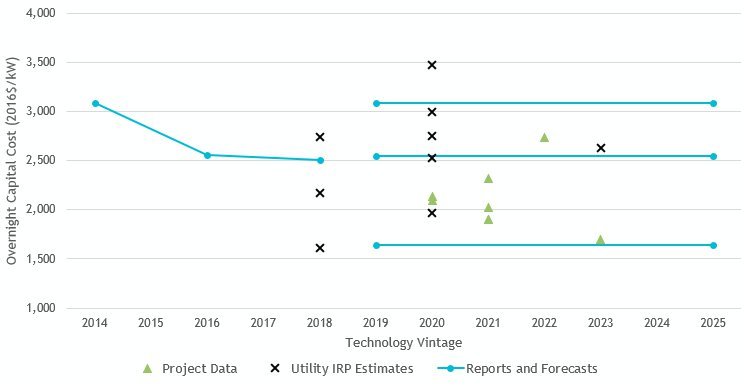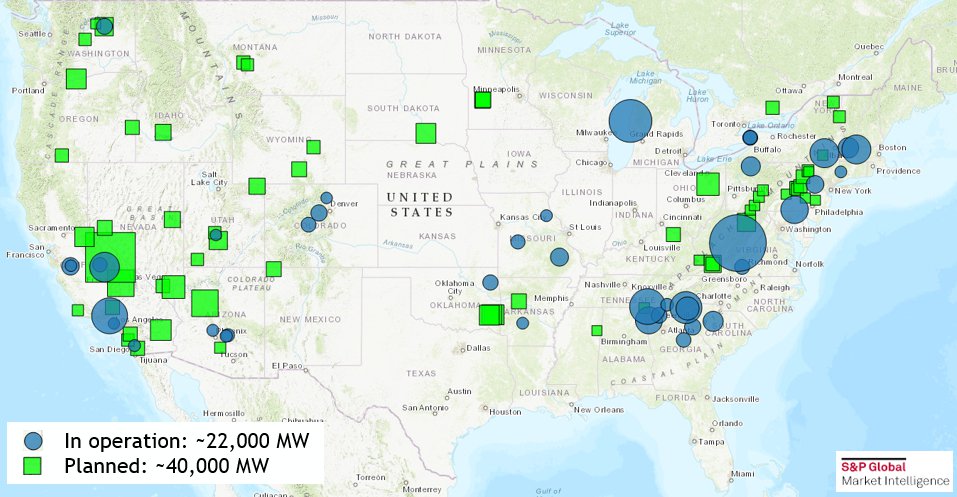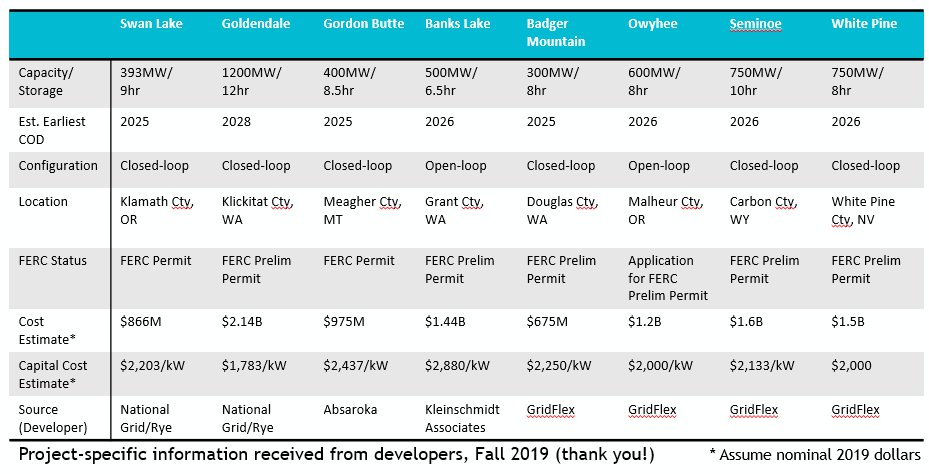Pumped Storage
Jump to: Trends, Considerations, and Resource Potential | Description of Reference Plant
Pumped storage hydropower is an established and commercially mature energy and storage resource, however there has been limited development in the Pacific Northwest to-date. A typical project consists of an upper reservoir and a lower reservoir connected by a water transfer system with reversible pump-generators. Energy is stored by pumping water from the lower reservoir to the upper reservoir and generated by releasing water from the upper reservoir through the turbines to the lower reservoir. In the Seventh Power Plan, the Council categorized pumped storage as an emerging technology because of advances in technology and added uses of pumped storage – expanding its role from primarily shifting energy to providing additional ancillary services.
Clean energy policies have been adopted across the western interconnect, leading to the planned significant development of renewable resources like wind and solar. As a result, energy storage technologies are being considered to utilize surplus renewable generation (in lieu of curtailment) and save the energy for when it is needed in the peak or heavy load hours. Over the past five years, several major pumped storage projects have progressed through the development pipeline and some have received FERC licenses. At the time of the 2021 Power Plan, none of the projects in the pipeline have officially broken ground.
Pumped Storage Trends, Considerations, and Resource Potential
Jump To: Technology Trends | Cost Trends | Development Trends | Environmental Effects | Resource Potential in Region | Opportunities and Challenges
The following section describes high level trends in technology, cost, and development for pumped storage. In addition, it identifies resource potential in the region, opportunities and challenges, and environmental effects.
Most existing pumped-storage projects were designed to shift energy from off-peak hours or low demand periods to times of peak demand. Advances in technology, for example adjustable variable speed pumps (instead of fixed speed pump units) and ternary units (allowing the turbine and pump to operate simultaneously), have made it possible for pumped storage to better provide capacity, frequency regulation, voltage and reactive support, load following, and longer-term shaping of energy from variable-output resources.
There are two major types of pumped storage project configurations – open-loop and closed-loop. Closed-loop projects are independent of any naturally flowing water source, essentially two reservoirs that shift the same body of water between them (with initial reservoir fill and additional water to replenish for losses such as evaporation). An open-loop system is connected to a naturally flowing body of water (like a river) where water is pulled from the continuously flowing lower reservoir and pumped to the upper reservoir for storage. When the water is released from the upper reservoir through the turbine generators, it returns to the naturally flowing body of water. Of the projects proposed for the Pacific Northwest, the majority utilize a closed-loop configuration.
Costs for pumped storage projects vary significantly, depending on project size, configuration (closed-loop vs. open-loop), technology, existing infrastructure (for example existing natural reservoirs vs. man-made reservoirs), access to a water source, and environmental considerations. Therefore, costs are site-specific and with limited development, trends – if any - can be difficult to identify. Of the proposed projects in the region, the estimated capital costs as of 2019 ranged from about $1,700 to $2,700/kW. However, many of the studies and utility integrated resource plans at the time projected costs to a slightly higher range of around $3,500/kW.
Overnight Capital Cost of Pumped Storage

According to the U.S. Energy Information Administration (EIA), the majority of pumped storage plants in operation today were built in the 1970s and 1980s. Very little development has occurred since the mid-1990’s. As of 2020, there were about 22,000 megawatts of pumped storage in operation – with almost double that amount planned for development.
Operating and Planned Pumped Storage Projects in the United States

The majority of projects currently in the development queue are closed-loop configurations. Capacity ranges from a minimum of 400 megawatts to 1,200 megawatts and energy discharge ranges from 6 hours to 12 hours. The following table provides the project specifications and variables – as of Fall 2019 - from projects in development in the region. Staff recognizes that changes may have occurred to some of these project variables since then, but these were current when the reference plant was developed.
Pumped Storage Project-Specific Data, Frozen as of Fall 2019

See the Environmental Effects of Generating Resources for a high-level summary of some of the primary environmental effects of hydropower. For an in-depth description of the lifecycle impacts associated with electricity generation, see Appendix I of the Seventh Power Plan.
The pumped storage reference plant considered and assessed by the Council for the 2021 Power Plan is assumed to comply with existing environmental regulations governing air and water emissions, siting regulations, waste disposal, and fish and wildlife protection and mitigation costs when quantifiable and directly attributable to the new resource. Extensive environmental impact statements throughout the siting and licensing process as authorized by FERC are accounted for in the overall project cost. For more information, see the section on Federal Statutes and Regulation Updates and the Methodology for Determining Quantifiable Environmental Costs and Benefits and Due Consideration.
Resource Potential in the Region
Pumped storage projects require suitable topography and geologic conditions for either constructing upper and lower reservoirs at significantly different elevations within close proximity, or for taking advantage of naturally occurring water flows and existing/natural reservoirs. In addition, a nearby water supply is required for initial reservoir charge and occasional replenishment for losses due to evaporation. There about 4,000 megawatts of pumped storage across the identified projects in development in the region today, but since pumped storage is site specific, that number could increase as more sites are explored (or decrease as sites are ruled out).
Pumped storage provides a large-scale, carbon-free resource (although the carbon content of the initial charge depends on the energy source) in a region with clean and renewable policy standards and goals. Pumped storage has the ability to provide flexible capacity and energy balancing to the grid, augment renewable generation and reduce renewable curtailment, provide energy arbitrage (buying and storing cheap surplus electricity and discharging it during more expensive, peak times for a profit) and ancillary services (such as reserves and frequency control). In addition, pumped storage offers a longer duration energy discharge, especially when compared to battery storage alternatives. As utilities and states are ramping up development of renewable resources to comply with policies and goals, energy storage options are being considered as strategic hybrid or standalone configurations to maximize and shape the renewable energy output.
Pumped storage development has a long lead time (five to ten years), especially when compared to battery storage and other generating resource options. In addition, a pumped storage project requires a significant upfront capital investment and the return on that investment isn’t as straightforward as a typical generating project. Pumped storage requires “fuel” – electricity purchased or generated from another generating resource(s) – and the value it provides can be difficult to quantify and monetize. There are also considerable environmental and siting challenges when developing a project of this magnitude and amount/complexity of infrastructure, and these challenges are often site-specific and therefore best practices are not always transferrable from project to project.
America’s Water Infrastructure Act of 2018 (AWIA) introduced five major components of hydro reform, two in particular of benefit to pumped storage development. AWIA extended the preliminary permit terms and start of construction deadlines for new construction projects by authorizing FERC to issue preliminary permits for up to four years (as opposed to three years under previous regulation) and to extend a preliminary permit once for up to four years (as opposed to two years under previous regulation). This essentially extends the maximum term for a developer to hold a preliminary permit from five years to eight years. In addition, for closed-loop pumped storage projects, AWIA ordered FERC to establish an expedited process to ensure a final decision on an application for a project license is made no later than two years after the receipt of the completed application. These two provisions help developers to preserve their hold on prospective pumped storage sites while completing their due diligence on project feasibility as well as expedite the licensing process once they have completed all of the FERC requirements.
Description of Pumped Storage Reference Plant
The pumped storage reference plant is based off of proposed projects in the region that are in the advanced planning stages. The reference plant assumes a closed-loop configuration with variable speed pumps and a capacity of 400 megawatts with an 8-hour energy discharge. While there are certainly possibilities for projects with higher discharge times (for example, 12-18 hours), the Council based its reference plant on the known proposed project developments at the time. The reference plant and costs include all siting and licensing, infrastructure, step-up transformers, switchgear and interconnection facilities, and security, control, and maintenance facilities. For modeling purposes, the reference plant is located east of the cascades and the earliest in operation date is 2025.
Pumped Storage: 2021 Power Plan Reference Plants
| Reference Plant | Pumped Storage |
| Technology Type | Closed-loop, variable speed pump |
| Configuration | 400 MW/8hr |
| Nameplate Capacity (MW) | 400 MW |
| Location | East of Cascades (but could be anywhere suitable) |
| Avg. Annual Capacity Factor | – |
| Round-trip Efficiency | 80% |
| Heat Rate – HHV (Btu/kWh) | – |
| Economic Life (Years) | 50 |
| Tax Benefits | – |
| Financial Sponsor | IOU |
| Development Period (Yrs) | 1 |
| Construction Period (Yrs) | 1 |
| Earliest In-Operation Date | 2025 |
| Overnight Capital Cost ($/kW) | $2,300/kW |
| All-in Capital Cost (pre-tax benefits) ($/kW) | $2,667/kW |
| All-in Capital Cost (w/ tax benefits) ($/kW) | – |
| Fixed O&M Cost ($/kW-yr) | $14/kW-yr |
| Variable O&M Cost ($/MWh) | $0/MWh |
| Transmission | IOU NT |
| Deferred Transmission and Distribution ($/kW-yr) | $9.93/kW-yr |
| Maximum build-out (MW) | 4,000 MW (10 units) |
*All costs in 2016 year dollars. For more details and definitions of resource attributes, see Definitions of Reference Plant Components.
Maximum buildout: The maximum potential for pumped storage in the 2021 Power Plan is limited to 4,000 MW (10 reference plants). This estimate is based off of the projects currently in development in the region and what is realistically achievable over the next two decades.
Forward capital cost curves: Due to the site-specific nature of pumped storage development, there is no cost improvement applied to the reference plant over the planning horizon. In other words, the costs identified can be viewed as estimates within a range of expected new development costs over the next few decades.
More information: For background analysis, see the initial presentation on pumped storage from the October 2019 GRAC meeting. Please note that some of the material in the presentation may have been updated between that meeting and the draft plan. In addition, see the capital/FOM/VOM cost workbooks for all resource reference plants as well as MicroFin for supplementary inputs and analysis.



